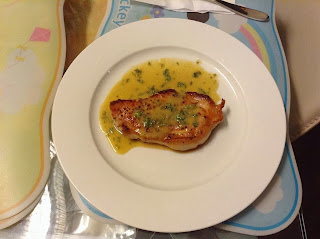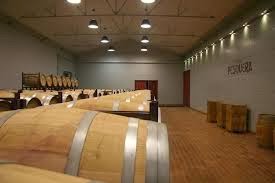The
history of Chateau Brane-Cantenac could be traced back to the early 18th
century, when it was under the ownership of the Gorce family, with the estate known
as Chateau Gorce. The family probably acquired the estate around 1735, and had
been active in viticulture. Under Marie-Francoise Gorce the estate expanded to
40 hectares, with the increasing price signifying the quality of the wine, which
was on par with what Mouton was selling at the time.
In 1833
the estate was acquired by Baron Hector de Brane, who sold Brane-Mouton to
finance the sale, renaming it Brane-Cantenac in 1838. Hector was also responsible
for identifying Cabernet Sauvignon as Medoc’s number one grape, earning him a
nickname Napoleon des Vignes. It was ranked a second growth in the 1855
classification
The
estate was later bequeathed to Jacques-Maxime, who subsequently sold to Gustave
Roy, who owned d’Issan. During the vineyard disasters, phylloxera and oidium,
war and economic depression, the quality went into decline. The estate was sold
in 1919 to the Societe des Grands Crus de France, a consortium that also owned
Margaux, d’Issan and Durfort-Vivens. The dissolution of this company in 1925
saw the estate sold to the current owners, the Lurton family.
Francois
Lurton later passed the estate to his son Lucien, who made significant
expansion and improvement. In 1992 he passed to his son Henri, who had spent
many years gaining experience far beyond Bordeaux’s border, which was something
special at the time. Henri also got a handful of wine qualifications. Through
his dedication, today the quality had come back to the level expected for a
deuxieme cru standing, and still gradually improving.

The
vineyards amount to 75 hectares, with three main terroirs: the large sweep of
gravel in front of the chateau at the top of Plateau de Brane, which is a thick
layer of surface gravel up to 12 metres deep, with wines of high quality tannin
with silky-velvety presence. The second section is centred around and behind
the chateau, with a gravel soil but higher proportion of sand and no clay, and
a lower water level, with stronger tannin. The third section is on the other
side of Route d’Arsac, La Verdotte, with gravelly sand soil and adopting
organic viticulture since 2010.
 The
vines are planted at 8000 vines per hectare, at an average age of 35 years. Cabernet
Sauvignon covers 55% of the vineyard, with 40% Merlot, 4.5% Cabernet Franc and
0.5% Carmenere. The fruit is picked by hand with typical yield of 45 hl/ha,
transported using the Air Tec system which cushions the fruit from damage. At
the reception area the fruit sees double sorting, one in the vineyard and the
other in the cellar. The fruit is mechanically destemmed and sorted using
optical technology.
The
vines are planted at 8000 vines per hectare, at an average age of 35 years. Cabernet
Sauvignon covers 55% of the vineyard, with 40% Merlot, 4.5% Cabernet Franc and
0.5% Carmenere. The fruit is picked by hand with typical yield of 45 hl/ha,
transported using the Air Tec system which cushions the fruit from damage. At
the reception area the fruit sees double sorting, one in the vineyard and the
other in the cellar. The fruit is mechanically destemmed and sorted using
optical technology.
In 1997
new fermentation options were introduced with new oak vats, adding to the
choice of stainless steel and concrete vats. Now half of the production
undergoes malolactic in barrel. In 1999 the buildings also saw extensive
renovating, with a new chai using greener technology and environmentally
sensitive materials.
 The
freshly harvested fruit sees a cold soak, with concentration methods used in
wet vintages to reduce water contents of the must by vacuum extraction. Fermentation
is under temperature control between 7-10 days, with pumping over and pigeage,
and even delestage. Maceration is carried out between 20-30 days before
pressing, with the wine fed into barrels of 60-70% new oak, for malolactic
fermentation.
The
freshly harvested fruit sees a cold soak, with concentration methods used in
wet vintages to reduce water contents of the must by vacuum extraction. Fermentation
is under temperature control between 7-10 days, with pumping over and pigeage,
and even delestage. Maceration is carried out between 20-30 days before
pressing, with the wine fed into barrels of 60-70% new oak, for malolactic
fermentation.
The wine
is left on lees for several months, with topping up. Finally the wine is tasted
before blending, and racking is also done. The wine is aged in oak for 12
months for Baron de Brane, the second wine, and 18 months for the grand vin
before fining by egg-white and bottling. About 12500 cases each of first and
second wine is produced each year.
I have
recently tasted the 2004 vintage and below is my tasting note:
Appearance
Bright and clear, this wine is of medium
ruby color, with garnet rims and legs.
Nose
Clean,
the nose shows medium intensity aromas of black fruit such as blackberry and
blackcurrant, oak notes of cedar and toast, maturity notes of savory, sweet
spice of cloves, floral notes of violet. The wine is developing.
Palate
Dry with
medium acidity, medium tannin of soft and silky texture, the wine has medium alcohol
and is of medium body with medium intensity flavors of black fruit such as
blackberry and cassis, oak notes of toast and cedar, floral notes of violet,
maturity notes of savory. The wine has a medium finish.
Conclusion
Good
quality Margaux GCC with a reasonably intense nose showing good complexity, the
wine has exhibited signs of development but still got ample room to further
evolve. On the palate it is balanced and elegant, with fair concentration and
complexity, as well as a good finish. Ready to drink now but can benefit from
further ageing of another 3-5 years.

























